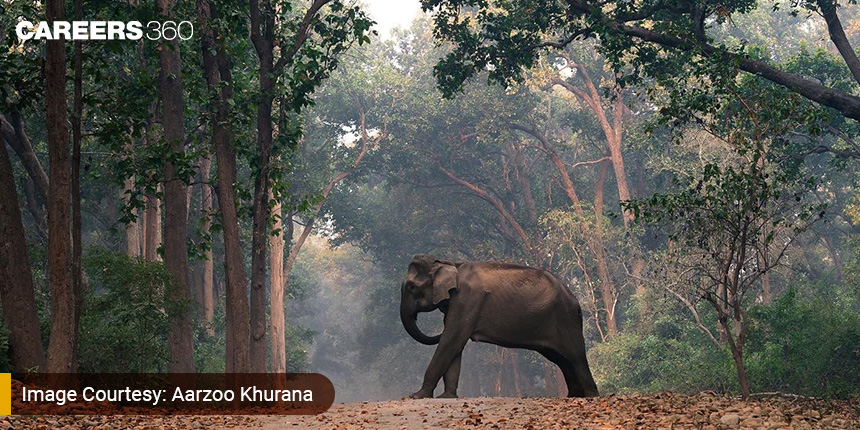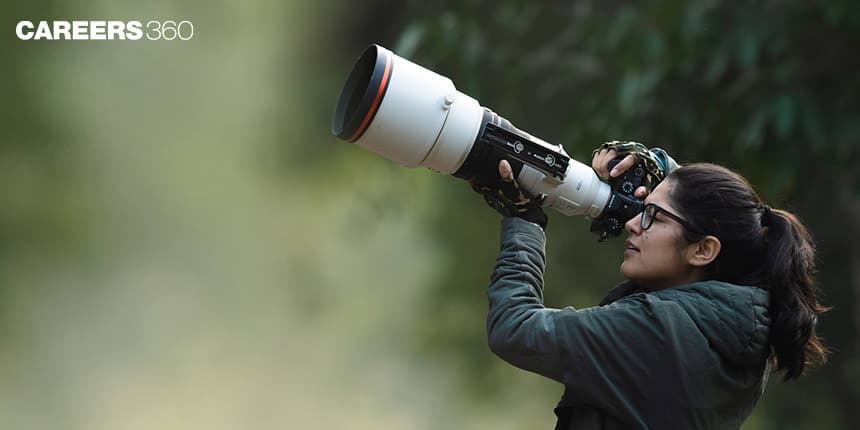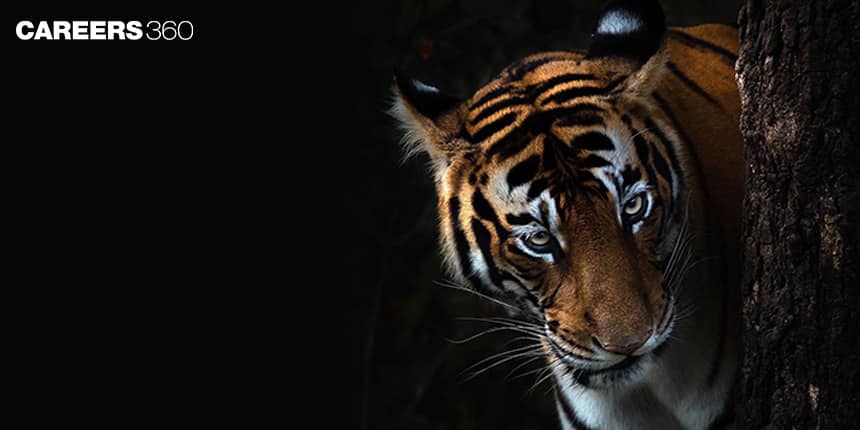Wildlife photography, like all photography, is about bringing a ‘not-so-common’ image to everybody who would care to look, and for that, a photographer has to make certain creative choices, like what to show and what to keep out of the frame, which makes photography the art of selective revelation as well as creative concealment. These two are sides of the same coin, for one cannot exist without the other.

Wildlife photography has its own unique challenges, which arise from the fact that unlike many other kinds of photography, the artist does not have control over the subject, and the surroundings in which the job has to be done are inherently and almost invariably, dangerous. So the challenges go way beyond framing the shot and clicking the button at the right moment.
There are so many other things that need to be taken care of, and just one of them is the wild animals that might see a strange, unfamiliar creature with a funny device in hand as a threat to be fought, which might translate into their mounting a physical attack without notice. Therefore, in addition to knowing how to click good images, one also has to be familiar with the jungles as well as the general disposition of the creatures, including big and small animals, that might be found in one’s area of work. That’s many more than a few things to keep in mind.
Requisite Aptitude: Perseverance And Patience
To be a wildlife photographer one has to have a good eye for a decent frame, which takes both time and practice apart from a bit of talent — may be more than a bit — although even if one is a little short on talent, it can be more than just compensated by hard work and perseverance. But loads of talent with no perseverance and hard work would amount to nothing.
Perseverance does not come in handy for just a budding wildlife photographer, but is a virtue also for wildlife photographers at all levels of performance and ability, from novices to veritable geniuses. One needs persistence not only to pick and polish the necessary skills to be a wildlife photographer, but also to capture the exact same image on the sensor as one has on one’s mind, which can be particularly difficult because even in normal circumstances, it takes a remarkable degree of patience and persistence to get an interesting image of a wild animal in its natural habitat, and if one has a specific kind of image in mind, the task gets difficult many times over.
Patience is another thing that one has to have if one has to be able to take decent pictures of wildlife creatures because they come and go, eat and drink, roll and stand of their own free, wild will, and do not care what the photographer lying in wait would want them to do for the camera. One, therefore, needs loads of patience to click evocative images in the wild.
Training: The Jungle Is Your School
For a wildlife photographer, all the training takes place in the jungles, amid the forests and the wild creatures, but before one enters the forest with a camera in hand, one must have a good understanding of not only the equipment one is carrying, but also of the kind of settings that would work best to capture certain kinds of images because wild creatures keep moving and the scene in the wild keeps changing constantly; one moment it’s there, the next it’s gone. One has to be constantly on one's toes for the capturable moment may occur any second, and that requires an understanding of the light conditions, camera settings most suitable for each set of light conditions, and the probable light conditions that might emerge in a given wildlife setting, which clearly requires a good understanding of the wild as well. One has to be able to anticipate a large number of probable shots well before the elements in the wild come together to present the opportunity for a similar shot.
 Technical Proficiency Is Irreplaceable (Picture Credits: Aarzoo Khurana)
Technical Proficiency Is Irreplaceable (Picture Credits: Aarzoo Khurana)
Much of it comes through practice in the forests, but most of the general photography techniques that come in handy in wildlife just as well as in any other kind of photography can be learnt through general photography courses or courses and workshops specifically designed for wildlife photography. One might go for a general photography training course before enrolling in a course for wildlife photography, or enrol in the latter directly if one is prepared to put in the extra work an advanced, specialised photography course demands.
Technical Know-How: Master The Equipment And Its Use In The Wild
Knowing how your camera works and how different lenses and settings come together to produce different kinds of images, are the basics that take a while for one to master, but for a wildlife photographer, it’s important to know what sort of combination of all these things works in the wild, and how to quickly change from one setting to the other with minimal movement to get the best pictures in different wildlife milieus. Furthermore, wildlife is not just about going into the wild with a certain kind of setting on the camera and clicking away at whatever catches one’s fancy, because there are many kinds of forests and wildlife settings, and there are many creatures in the wild engaged in different activities, and the variety of those things make things tricky for a wildlife photographer. This means that one has to first master the equipment (the camera, lenses, and the internal settings on the camera), and then master the art of adapting the camera settings to capture specific wild creatures in their natural habitat. And that’s where practice and hard work come in.
Hard Work: A Series Of Small, Progressive Steps
Simply working hard without giving much thought to what the hard work is for is like incessantly digging without knowing the purpose the dug hole has to serve, which might give one a lot of practice at digging and that might turn out to be useful in some ways, but it would still not make one a master digger of anything; only a general digger who is more of a labourer than a craftsman. And, true wildlife photography is labour intensive. It’s still a craft to be mastered rather than just plough-work to be pursued with blind labour. As the cliche goes, don’t just work hard, work smart as well. And that just means one should work hard towards the right goals the right way, which applies to wildlife photography just as much as to anything else worth pursuing.
Start small, and try concentrating on the creatures that are commonly found around you. There is no point in wasting all that money to take a trip to the forest and go on safaris when you don’t exactly know how to take decent pictures of wild animals. It starts with capturing animals, and once you have mastered that, you can proceed to clicking wild animals.
 Work Hard For The Big Cats (Picture Credits: Aarzoo Khurana)
Work Hard For The Big Cats (Picture Credits: Aarzoo Khurana)
There are birds, dogs, cats, and many other animals all around, and one can begin by clicking interesting images of these everyday creatures, which makes for good practice. Birds make exceptionally good practice subjects for a budding wildlife photographer. That’s how I began, and you can, too. So, go ahead, and try clicking pictures of the birds in flight, birds eating, birds nursing their young ones, and all other bird things that different birds do.
Know Where You Are Headed
Before you set yourself on the path of wildlife photography as a career, you might want to take a moment and understand that you are not going to be a doctor, engineer, or a lawyer, and this is a completely unconventional field. And that means that much of it is uncharted territory, and you’ll have to find ways to sustain yourself through other sources before your career as a wildlife photographer takes off. It can take a while for you to be able to fetch enough money through wildlife photography. Furthermore, it would not be easy for you to explain what you do for a living to your older relatives, and some of them might get judgmental about your “whiling away time in doing worthless things” (not all relatives are kind to your face; none behind your back, of course). So, there are social and economic challenges, too. And it would be better if you are prepared for them in advance. If you want to do it as a hobby, great. But if you want to pursue it as a career, it is different altogether.
Wildlife photography as a hobby is way different from what it is as a profession, and it is advisable that you take it up as a hobby and see where it goes before jumping into it as a full-time, professional wildlife photographer. It’s a developing field and there are not many avenues open for you, like they are in other areas after you have passed a qualifying exam, and of course, there is no qualifying exam as such, although there are many training programs that you can enrol in to become finer at the art. As a matter of fact, very few wildlife photographers are earning a living from wildlife photography alone. My parting words, therefore, would be, go slow, take it easy, test the waters, and then see how far you can go into it. Like everything else worth doing, it’s not easy but it’s very rewarding once you are into it.
- Aarzoo Khurana is one of India's most celebrated nature and wildlife photographers (an Advocate by qualification). She has mentored hundreds of aspirants of wildlife photography through her workshops, training programs, and webinars. She has been a TEDx speaker, and addressed students at renowned institutions like NIT Surathkal and PDEU, Gujarat. She is Sony Alpha Ambassador, noted by BBC, Discovery, and NatGeo. Aarzoo can be reached at www.aarzookhurana.com